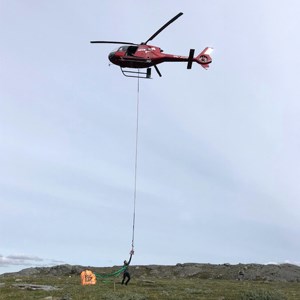Contact
 Eveline Krab
Eveline Krab
Associate Senior Lecturer at the Department of Soil and Environment, SLU
Telephone: 018-672470, 0725-115379
E-mail: eveline.krab@slu.se
CV-page

A square meter of arctic tundra soil can contain over a million soil animals and uncountable numbers of bacteria and fungal hyphae. These soil organisms are omnipresent, are tremendously diverse and are known to play a major role in carbon turnover by constantly ingesting, excreting and respiring part of this carbon by feeding on dead organic material.
This summer, we a started a new project in the Swedish mountains around Abisko, to study the effect of climate change on interactions between these organisms and its consequences for carbon cycling. The first step of this project was logistically challenging: about 800 kg of soil had to be transported down from the mountain, and then up again!
The arctic region not only provides us with beautiful landscapes that sustain reindeer husbandry and harbor a unique biodiversity; it provides one of its most important services by storing over a third of the worlds’ soil carbon in its soils. This carbon may increasingly be released into the atmosphere as a result of climate change.
A major difficulty in improving our predictions of the magnitude of this carbon release is that the direct effects of temperature on biochemical processes often fail to explain field observations, as decomposition processes that largely underlie soil carbon release can be strongly mediated by biotic interactions. To be able to accurately extrapolate the effects of climate warming to larger scale carbon-dynamics, we therefore started a new project to gain better mechanistic understanding of climate effects on carbon-release by studying its impacts on soil decomposer organisms and their interactions.
For the first experiment of this project that we established this summer, we use natural temperature changes with altitude as a space-for-time substitute for climate warming. Two sites were chosen to establish two ‘common gardens’: one conveniently located near the research station of the Swedish Polar institute at about 350m altitude, and one up in the mountains at 720m altitude. This corresponds to an average air temperature difference of about 3-4 ⁰C.
In these gardens, we placed transparent plastic boxes that we filled with intact soil turfs collected from the five most common soil/vegetation types found in this subarctic environment. These turfs were collected from areas at an altitude of about 550 m, which meant the boxes had to be filled and then carried down to the research station to be prepared for transport to their respective common garden.
– This was a great effort for which I luckily had a great team: we filled and carried a total of 144 boxes with about 5-6 kg of soil each. Half of the boxes was afterwards transported up to the common garden in the mountains, this time using the local helicopter company. The final step in this logistical operation was to establish these mesocosms into the soil to create as natural climatic soil conditions as possible, says researcher Eveline Krab.
Now these soils wait for winter to come in their respective gardens before the 2019 field season to begin, when we will try to unravel if and how the soil fauna and microbial communities differ between the soils in their gardens, and if the resulting changes will impact on carbon releases from these soils.
 Eveline Krab
Eveline KrabAssociate Senior Lecturer at the Department of Soil and Environment, SLU
Telephone: 018-672470, 0725-115379
E-mail: eveline.krab@slu.se
CV-page